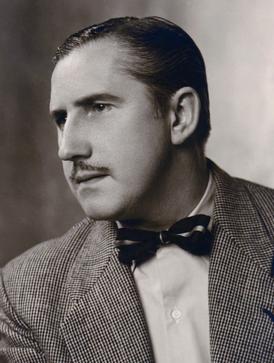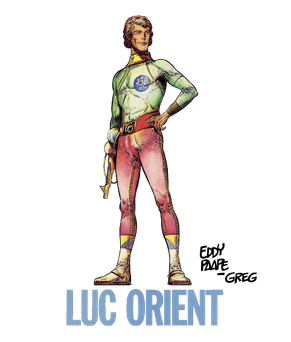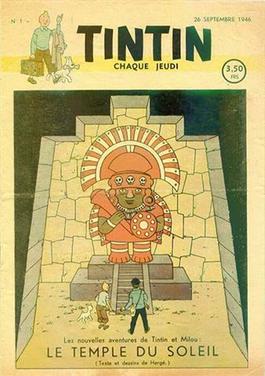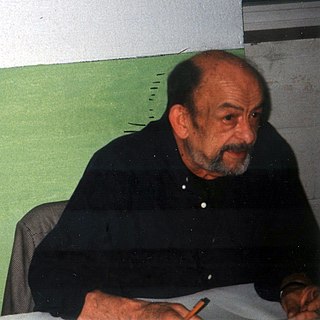
Ligne claire is a style of drawing created and pioneered by Hergé, the Belgian cartoonist and creator of The Adventures of Tintin. It uses clear strong lines sometimes of varied width and no hatching, while contrast is downplayed as well. Cast shadows are often illuminated, and the style often features strong colours and a combination of cartoonish characters against a realistic background. The name was coined by Joost Swarte in 1977.

Jacques Martin was a French comics artist and comic book creator. He was one of the classic artists of Tintin magazine, alongside Edgar P. Jacobs and Hergé, of whom he was a longtime collaborator. He is best known for his series Alix. He was born in Strasbourg.

Edgard Félix Pierre Jacobs, better known under his pen name Edgar P. Jacobs, was a Belgian comic book creator, born in Brussels, Belgium. He was one of the founding fathers of the Franco-Belgian comics movement, through his collaborations with Hergé and the graphic novel series that made him famous, Blake and Mortimer.

Joseph Gillain, better known by his pen name Jijé, was a Belgian comics artist, best known for being a seminal artist on the Spirou et Fantasio strip and the creator of one of the first major European western strips, Jerry Spring.
Le Lombard, known as Les Éditions du Lombard until 1989, is a Belgian comic book publisher established in 1946 when Tintin magazine was launched. Le Lombard is now part of Média-Participations, alongside publishers Dargaud and Dupuis, with each entity maintaining its editorial independence.

Cubitus is a Franco-Belgian comics series, and the basis for the Wowser cartoon series appearing in the United States. Cubitus was created by the Belgian cartoonist Dupa, and features Cubitus, a large anthropomorphic dog, who lives with his owner Semaphore. Cubitus is known as Dommel in Flanders and the Netherlands, Muppelo or Pom Pom in Finland, Teodoro in Italy, Zıpır in Turkey and Доммель in Russia. His name derives from the old anatomical name of the ulna bone, supposedly derived from the Greek kybiton (elbow).

Oumpah-pah le Peau-Rouge is a comics series created by comics artist Albert Uderzo and comics author René Goscinny, best known as the creators of Asterix. The series first appeared in the weekly Tintin magazine in 1958 though it remained serialised for a relatively short time, ending in 1962. The stories were published in book form by Lombard and Dargaud starting in 1961. In 1995, the series was reissued by Albert Uderzo's own publishing house, Les Éditions Albert-René.
Notable events of 1950 in comics.

Luc Orient is a Belgian science fiction comic series featuring an eponymous hero, created in 1967 by the writer Greg and the artist Eddy Paape. It belongs to the large family of Franco-Belgian comics.

Tintin was a weekly Belgian comics magazine of the second half of the 20th century. Subtitled "The Magazine for the Youth from 7 to 77", it was one of the major publications of the Franco-Belgian comics scene and published such notable series as Blake and Mortimer, Alix, and the principal title The Adventures of Tintin. Originally published by Le Lombard, the first issue was released in 1946, and it ceased publication in 1993.

Paul Cuvelier was a Belgian comics artist best known for the comic series Corentin, published by Le Lombard, which first appeared in the first issue of Tintin magazine.
René Follet, sometimes known by the pen name Ref, was a Belgian illustrator, comics writer and artist.

Willy Maltaite, better known by the pseudonym Will, was a Belgian comics creator and comics artist in the Franco-Belgian tradition. In the genre known in Francophone countries as bande dessinée, Will is one of the young cartoonists trained by Jijé, who made them live and work with him in his studio in Waterloo. He is considered one of la Bande des Quatre, and a founding member of the Marcinelle school.

Ric Hochet is a Franco-Belgian comics series created by Tibet (drawings) and André-Paul Duchâteau (scripts). It first appeared on March 30, 1955, in the Franco-Belgian comics magazine Tintin.

Zig et Puce is a Franco-Belgian comics series created by Alain Saint-Ogan in 1925 that became popular and influential over a long period. After ending production, it was revived by Greg for a second successful publication run.

Tibet, the pseudonym of Gilbert Gascard, was a French cartoonist in the Franco-Belgian comics tradition. Tibet, who debuted in 1947, is known for work produced for the Franco-Belgian comics magazine Tintin, most notably the long-running series Ric Hochet and Chick Bill.

Robert Frans Marie De Moor, better known under his pen name Bob de Moor, was a Belgian comics creator. Chiefly noted as an artist, he is considered an early master of the Ligne claire style. He wrote and drew several comics series on his own, but also collaborated with Hergé on several volumes of The Adventures of Tintin. He completed the unfinished story Professor Sató's Three Formulae, Volume 2: Mortimer vs. Mortimer of the Blake and Mortimer series, after the death of the author Edgar P. Jacobs.

Bruno Brazil is a Franco-Belgian comics series written by Greg, under the pseudonym Louis Albert, and drawn by William Vance. It was initially serialised in the Franco-Belgian comics magazine Tintin, first appearing on January 17, 1967. The first album publication was in 1969, while the latest album was first published in 1995. While Dargaud had initially published the series up to the penultimate volume, the rights were eventually passed on to Le Lombard, which is part of the same holding company, Média-Participations, and the final volume was published under its banner. As of today, the series is yet to be published in English but is available in various other languages, including French and Spanish.

Raymond Leblanc was a Belgian comic book publisher, film director and film producer, best known for publishing works such as The Adventures of Tintin by Hergé and Blake and Mortimer by Edgar P. Jacobs. He debuted, published, and promoted many of the most famous Franco-Belgian comics. Leblanc and his two partners created Le Lombard publishing, Tintin magazine, PubliArt advertising agency, and Belvision Studios.
Jean-Pierre Vincent was a French theatrical actor and director.
















